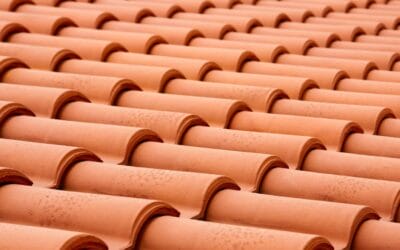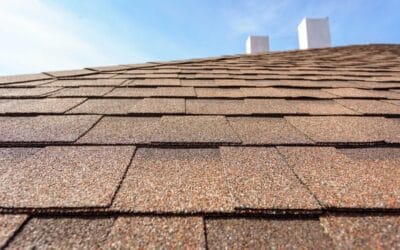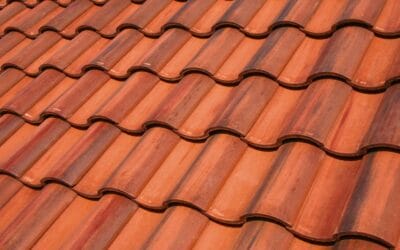Many issues on your residential roof stem from leaks occurring around your chimney, and the culprit is often the chimney flashing. This is an overview of the process of properly flashing a brick chimney as part of an effective roof system. This article is primarily focused on flashings that are tied into a composite asphalt shingle roof, as that is the most common roof type found in the US – however, the general flashing process is similar for other roof types as well.
Understanding the proper method of flashing a brick chimney is important to know not only if you are installing a roofing system and need to conduct the flashing yourself, but also to know if the job was done properly on a home you are considering purchasing, to identify if there is a flashing problem when trying to locate a roof leak, or simply to know if the flashing job was done properly if you recently had a roof repair or replacement done. Finally, identifying and knowing about proper chimney flashing is important to know what maintenance might be needed over the next few years on your brick chimney.
This article is split into two parts:
Part 1: How to Identify Issues with Existing Brick Chimney Flashing
-
-
-
- The two types of brick chimney flashing
- Signs you may have a bad chimney flashing
- Things that could cause a roof leak at/near a chimney that AREN’T a flashing problem
-
-
Part 2: How to Properly Flash a Brick Chimney
-
-
-
- Components and Materials
- Installation Process
-
-
Part 1: How to Identify Issues with Existing Brick Chimney Flashing
Chimneys, especially brick chimneys, are the number one leak site of residential roofing systems. Here’s what we’ll cover to learn more about how chimneys are supposed to look and how flashing systems work:
-
- The two types of brick chimney flashing
- Signs you may have a bad chimney flashing
- Things that could cause a roof leak at/near a chimney that AREN’T a flashing problem
First, there’s two types of brick chimney flashings:
| “Cut-in” or “Mortared-in” Counter Flashing: | Surface-Mount Counter-flashing |
| The top of the counter flashing is embedded in a mortar line of the masonry chimney | If it doesn’t have a stair step mortar and counter flashing and it has a surface mount counter flashing, the only thing preventing the water from entering behind the brick and the flashing is the bead of caulking. So if you have a surface mount counter flashing versus style, is has now become a maintenance issue; you would have to have somebody come look at your chimney and redo the caulking every five years |
THE WHY: Signs you may have a bad chimney flashing: How to identify the current or potential roofing system leaks near your brick chimney.
-
- You have a leak. Okay, sounds obvious, but this doesn’t necessarily mean it’s a flashing problem, it could come from the cap or the masonry itself
- You have an excessive amount of caulking and/or roofing cement over your flashings. Tar
- You see rust or deterioration of the metal flashings
- The metal is bent or curled away from the masonry
If the chimney flashings are installed correctly and the metal is in good condition, it usually indicates that there might be an issue somewhere else in the chimney structure. Things that could cause a roof leak at/near a chimney that AREN’T a flashing problem:
-
- Deteriorated mortar lines – look for loose, cracking, or missing mortar
- Chimney chase cover on top of the chimney could be rusted or damaged
- Rains lasting 4-5 consecutive days will often cause small leaks around masonry chimneys because brick and mortar itself are both porous, and will eventually saturate
- Cracked crown (is that the name). On a brick chimney, they usually just put cement on a crown, and if you look on the top of it sometimes that could be cracked all the way through, sometimes like a half an inch crack there. (A crown is only relevant if you don’t have a chimney chase topper). A temporary solution there in the meantime might be to coat with Uniflex
Part 2: How to Properly Flash a Brick Chimney
**Disclaimer. This really is a job best left to the professionals, especially for cut-in flashings that connect into a chimney at the mortar line. The cost and consequence of roof leaks into your home make this job high consequence. Furthermore, because of the potential safety and damage risks involved, most municipalities require any roofing work to have a building permit and inspection by the governing building authority. That said, here’s the components and process:
Components and Materials
When installing a chimney flashing on a brick chimney there are 5 main components:
-
- Cricket or saddle flashing located on the topside of the chimney
- An apron flashing located on the bottom side of the chimney
- Step flashing located on the sides of the chimney
- Counter flashing embedded into mortar joint
- Install Ice & Water barrier underneath the flashing for added protection against water intrusion
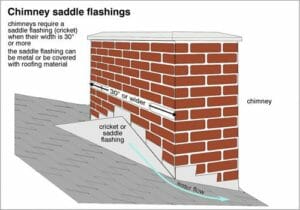
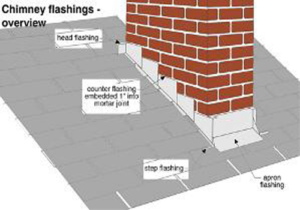
Installation Process:
- Remove all existing parts and flashings
- Inspect the decking to ensure a clean, nailable surface
- For all installation steps below, start at the bottom/ down-slope side of the chimney with all materials so that layers overlap in a way that sheds water rather than catching water
- Install ice and water shield (adhesive roof underlayment membrane)
- Install the apron flashing located at the bottom of the chimney
- Install step flashings up the side(s) of the chimney
- Install the “cricket” or saddle flashing located on the time side
- Apply roof underlayment onto the decking, nailed in with plastic caps
- Install shingles (again, starting from the bottom row, or “course,” and layering up, installing per manufacturers specification
- Install counter-flashings
If you install a new roof, it is very important to replace the chimney flashing at the same time. Be wary of discount roofing contractors who reuse chimney flashings, especially step flashings which are cheap to replace and usually get damaged in removal of the old roof. You want the flashing to last as long as the roof itself. As always consult with a reputable roofing contractor in your area.
Rhoden Roofing meets and exceeds all building codes, which allows us to pair the best available manufacturers product warranties with our own lifetime workmanship warranty. If you are in the greater Wichita area and worried about the state of your brick chimney or have a repair you are not comfortable doing yourself, we offer free inspections and are happy to come take a look.
This article is part of our ‘How To’ Series. Learn more about:
- Installation of Roof Components
- How To Fix Your Gutters: Most Common Repairs
- How Do You Properly Flash a Brick Chimney?
- What Is the Proper Installation & Flashing for a Heater Flue Pipe On a Pitched Roof?
- What Is the Best Temperature to Install Composition Shingles?
- How Do You Properly Flash a Curb Mounted Skylight on a Residential Roof?
- Building Science & Roofing Systems
- How to Improve Your Attic Ventilation
- Can You Install a Roof in the Winter in Kansas?
- What Is the Difference Between Open and Closed Valley Installation?
- Continuous Venting Ridge vs Static/Box Vents: Which is better?
- Reroof vs Recover; What Is the Difference and What Should I Do?
- Residential/ Steep Slope Materials Series
- Inspection & Hazards

